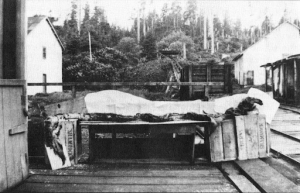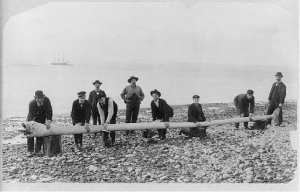Mysteries, Oddities, and Everything Strange: Cadborosaurus
May 3, 2023
Cadborosaurus: Yet Another Loch Ness Monster
A little trip down memory lane brings us to the origins of yet another sea monster. Throughout the world, many countries and towns have their own stories of serpents prowling local lakes and rivers, and more often than not, they are misinterpretations of floating objects or reflections. The cadborosaurus, yet another of these legends, is found on North America’s western coast bordering the Pacific Ocean and has inspired much debate and fanaticism on account of its existence. What sets it apart from the rest of the Loch Ness Monsters patrolling bodies of water around the world?
 On November 10, 1930, a carcass that was thought to be a whale was uncovered on Glacier Island near Alaska. Many other similar sightings had been reported throughout the decade, being located off the coast of Washington state. It was reported to look like a serpent or sea snake with a head similar to a horse, an extensive neck, small flippers in the front, and powerful webbed flippers in the back to assist the creature in movement. Accounts of the native people in Canada, known as the First Nations, show a sea serpent-like creature very similar to the cadborosaurus moving up north to escape the warmer waters. Alaskan Inuits use a similar image on their watercraft to scare away intruders.
On November 10, 1930, a carcass that was thought to be a whale was uncovered on Glacier Island near Alaska. Many other similar sightings had been reported throughout the decade, being located off the coast of Washington state. It was reported to look like a serpent or sea snake with a head similar to a horse, an extensive neck, small flippers in the front, and powerful webbed flippers in the back to assist the creature in movement. Accounts of the native people in Canada, known as the First Nations, show a sea serpent-like creature very similar to the cadborosaurus moving up north to escape the warmer waters. Alaskan Inuits use a similar image on their watercraft to scare away intruders.
The most significant carcass found wasn’t a washed up animal, but instead a remnant of a sperm whale’s stomach. In 1937, whalers caught and prepared a sperm whale, only to find a foreign creature in its belly, and the crew grew excited over the discovery since they had never witnessed an animal like this before despite being extremely familiar with the surrounding marine life. It was measured almost 11 feet in length and was described as a cross between a dog and a horse. This carcass was never elaborated upon outside of its report, so the final fate of the odd animal has been up for debate for almost a century.
 Since the 1700s, there have been over 200 reported sightings along the west coasts of the United States and Canada of “Caddy”. There have been accounts in San Francisco Bay, Island View Beach near British Columbia, and the Saanich Inlet nearby Victoria Island. In 2009, footage was reportedly taken of the sea serpent, filmed in Nushagak Bay, Alaska. Kelly Nash unveiled a film reel that showed a small colony migrating through the water. The video clip managed to land a spot on Hilstranded, a Discovery TV show, but did not amount to any significant discoveries or findings.
Since the 1700s, there have been over 200 reported sightings along the west coasts of the United States and Canada of “Caddy”. There have been accounts in San Francisco Bay, Island View Beach near British Columbia, and the Saanich Inlet nearby Victoria Island. In 2009, footage was reportedly taken of the sea serpent, filmed in Nushagak Bay, Alaska. Kelly Nash unveiled a film reel that showed a small colony migrating through the water. The video clip managed to land a spot on Hilstranded, a Discovery TV show, but did not amount to any significant discoveries or findings.
So what are people seeing if not Caddy? Well, there are a multitude of different sea-dwelling animals that could fit the bill for a freakishly long sea serpent. The most common explanation is that of a whale, since they are prevalent in the Pacific Ocean and can be sighted along these coasts. Basking sharks also resemble the descriptions put forth of the cadborosaurus, as many of the decomposing bodies that people claimed as sea serpents were revealed to actually be basking sharks. A pair of police officers in 1943 also thought they were witness to the cadborosaurus in its natural habitat, but upon closer inspection, they suggested the creatures were sea lions. Finally, the massive giant oarfish could also easily be mistaken for a sea monster, reaching over 650 pounds at its heaviest and resembling the reported structure of the cadborosaurus.
 Two doctors who looked into the case of the cadborosaurus, Dr. Edward Bousfield at the Canadian Museum of Nature and Dr. Paul LeBlond at the University of British Columbia, examined nearly every lengthy animal to reside in the ocean. They looked at eels, seals, whales, sharks, and practically anything else that could resemble a beast of dark depths. They assumed that the 200 reports were all regarding the exact same species, which led many to question their findings and disregard their research. They co-wrote a book, Cadborosaurus: Survivor from the Deep, in which they investigated the tales that the indigenous groups of Canada and Alaska had described.
Two doctors who looked into the case of the cadborosaurus, Dr. Edward Bousfield at the Canadian Museum of Nature and Dr. Paul LeBlond at the University of British Columbia, examined nearly every lengthy animal to reside in the ocean. They looked at eels, seals, whales, sharks, and practically anything else that could resemble a beast of dark depths. They assumed that the 200 reports were all regarding the exact same species, which led many to question their findings and disregard their research. They co-wrote a book, Cadborosaurus: Survivor from the Deep, in which they investigated the tales that the indigenous groups of Canada and Alaska had described.
The pattern of sea monsters reported throughout the world must mean that the existence of a creature of that caliber is highly likely. The ocean is still mostly unexplored, and scientists across the world have a better understanding of the galaxy outside of Earth than the depths of the oceans upon it. Whatever lives in the depths of the millions of square miles of pure water covering the globe is, at this moment, a complete and utter mystery. Someday, we might discover whether creatures like the cadborosaurus have any actual merit to them, but for now, the real nature of the ocean and animals like Caddy might forever remain unknown.
Resources:
https://en.wikipedia.org/wiki/Cadborosaurus
https://tetzoo.com/blog/2020/11/16/cadborosaurus-carcass-review
https://www.metrofieldguide.com/folklore-nature-cadborosaurus/














































uggleslug • May 7, 2023 at 9:42 pm
I really liked this one! It’s very interesting to me. I would love to see more like it.